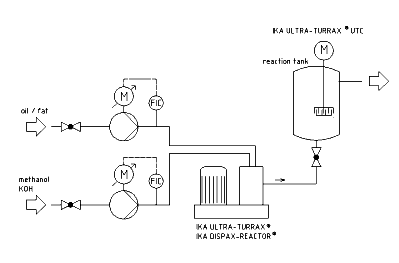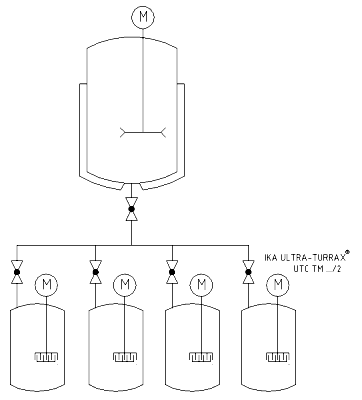


|
|||||
| ENVIROMENTAL TECHNOLOGY | |||||
| 1. Biodiesel | |||||
Biodiesel is made of native, growing again raw materials and is therefore getting more and more importance - from environmental as well as from economic point of view. For the production of biodiesel vegetable oils and used cooking oil and fat as well as animal fats are used. During the transesterification the preheated and prepared oil is mixed with an alcohol, mostly methanol, and an alkaline catalyst. During this process gylicerine is separated from the fat and replaced by three single alcohol molecules, resulting in biodiesel, a fatty acid alkyl ester, and glycerine. Biodiesel has similar characteristics as fossile diesel fuel and can thus be used in conventional diesel motors. |
|||||
| Production in a Continuous Process | |||||
 |
|||||
|
|||||
Advantages:
|
|||||
| Back to top | |||||
| 2. Preparations of vegetables oil | |||||
| Vegetable oils can be used as fuel in motors that are adapted accordingly. For use in conventional diesel motors fats have first to be transesterified and thus converted into so-called biodiesel. For both cases the raw vegetable oil has first to be "degummed". For this purpose proteins, carbides and phosphatides, that cloud the oil and are responsible for conglutination effects, have to be removed. Afterwards free fatty acids, that accelerate the spoiling of the oil and also disturb the conversion into biodiesel, can be removed by neutralization. |
|||||
| Production in a Inline Process | |||||
 |
|||||
| Vegetable oils are processed in following steps: | |||||
| 1. Degumming | |||||
| Part of the phosphatides in the raw oil are hydrogenizable with water and can thus easily be separated. The remaining non-hydrogenizable phosphatides can be separated by adding acid. The untreated oil is heated up to 60°C - 70°C and thoroughly mixed with up to 1% of phosphoric acid. The acid is reacting with the phosphatides, thus enabling a settlement of the water. The phosphatides can then be separated by filtration or centrifuging. This results in a "degummed" oil and gum resin, from which, under certain conditions, lecithin can be produced. For a thorough mixing of acid and oil the IKA®-dispersing machine type DISPAX-REACTOR® DR 2000 proved to be very suitable. |
|||||
| 2. Neutralization | |||||
| Free fatty acids (FFA) are influencing the taste of the oil and accelerate its spoiling. For neutralization of the FFA the oil is intensively mixed with sodium hydroxide at a temperature of approx. 90° to 100°C. The FFA are settling as soaps and can be sperated by centrifuging. The DISPAX-REACTOR® DR 2000 as well as the single stage dispersing machine of type ULTRA-TURRAX® UTL 2000 proved to be the right machines for neutralization of the FFA | |||||
| 3. Bleaching | |||||
| In order to remove remaining impurities like colour and oxidation products the oil can finally be bleached. For this purpose it is intensively mixed with bleaching clay. For this process we recommend the IKA® inline mixing and dispersing machine type MHD 2000. | |||||
| Back to top | |||||